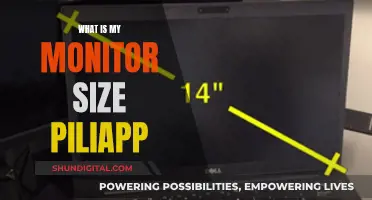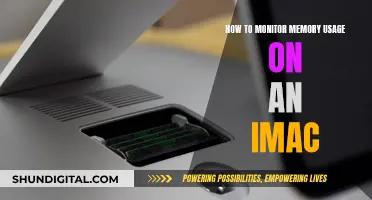
There is some debate over whether LCD monitors contain mercury. Some sources claim that LCD screens do not contain mercury at all, while others state that older LCD screens may contain small amounts of mercury. It is important to note that even if LCD screens do contain mercury, the levels are generally low, and the risk of exposure is minimal unless the screen is broken. Modern LCD screens typically use LED backlights, which do not contain mercury, while older LCD screens may have used CCFL backlights, which contain small amounts of mercury.
| Characteristics | Values |
|---|---|
| Do LCD monitors contain mercury? | LCD screens do not contain mercury, but older LCD screens were backlit by CCFL which does contain mercury. |
| What is the risk of mercury exposure from LCD monitors? | The risk of mercury exposure is minimal as LCD screens don't contain mercury. Older LCD screens that use CCFL backlighting pose a low risk unless the screen is broken, in which case the mercury vapour could evaporate over months or years. |
| How to dispose of LCD monitors that contain mercury? | Damaged LCD monitors that contain mercury should be disposed of at suitable collection points such as recycling, retail, or waste disposal businesses. |
What You'll Learn

Mercury in LCD backlights
LCD screens require a backlight to be visible. Older LCD screens used CCFL (Cold Cathode Fluorescent Lamp) backlights, which contain small amounts of mercury. Newer LCD screens use LED backlights, which do not contain mercury.
CCFL backlights work by exciting mercury vapour to generate light. While using a CCFL backlight as intended does not release mercury into the environment, a broken CCFL backlight may release mercury vapour. Therefore, it is important to dispose of products containing CCFL backlights properly.
The use of CCFL backlights in LCD screens is becoming less common, as LED backlights are more power-efficient and require less depth by design. However, some older LCD screens may still use CCFL backlights.
It is worth noting that simply touching mercury is not dangerous, and the risk of a broken CCFL backlight causing adverse health effects is minimal, especially in well-ventilated areas. Nonetheless, it is recommended to dispose of products containing CCFL backlights, such as older LCD screens, at designated collection points to reduce the risk of mercury exposure and minimise potential environmental impact.
Troubleshooting CNC Generals: Monitor Size Detection Issues
You may want to see also

Health risks of mercury exposure
Mercury is a naturally occurring element found in the air, water, and soil. It is toxic to humans and exposure to even small amounts may cause serious health problems. It is particularly dangerous to the development of children in utero and early in life. All humans are exposed to some level of mercury, mainly through inhalation of elemental mercury vapours during industrial processes and through the consumption of contaminated fish and shellfish.
The health risks of mercury exposure depend on several factors, including the form of mercury, the amount of exposure, the age of the person exposed, the duration of exposure, the method of exposure, and the health of the individual. The effects of mercury exposure can be severe, subtle, or non-existent, depending on these factors.
Methylmercury Poisoning
Methylmercury is an organic compound that is commonly found in fish and shellfish. People exposed to high levels of methylmercury may experience adverse health effects. Possible symptoms of methylmercury poisoning include loss of peripheral vision, "pins and needles" feelings in the hands, feet, and mouth, lack of coordination, and impairment of speech, hearing, or walking.
Methylmercury exposure is particularly dangerous for infants in the womb, as it can adversely affect their developing brains and nervous systems. Children exposed to methylmercury in utero may experience cognitive, memory, attention, language, fine motor, and visual-spatial impairments.
Metallic Mercury Poisoning
Metallic mercury mainly causes health issues when inhaled as a vapour, which can be absorbed through the lungs. Symptoms of prolonged and/or acute exposure include emotional changes such as mood swings and irritability, neuromuscular changes such as weakness and muscle atrophy, disturbances in sensations, changes in nerve responses, and poor performance on tests of mental function. Higher exposures may also lead to kidney damage, respiratory failure, and even death.
Inorganic Mercury Poisoning
High exposure to inorganic mercury may result in damage to the gastrointestinal tract, the nervous system, and the kidneys. Symptoms of inorganic mercury exposure include skin rashes and dermatitis, mental disturbances, and kidney damage.
Organic Mercury Poisoning
Organic mercury causes symptoms if inhaled or touched. Symptoms may not occur immediately and usually arise after long periods of exposure. However, exposure to a large amount of organic mercury at one time can cause symptoms such as numbness or dull pain in certain body parts, tremors, double or blurry vision, and potential blindness.
Pregnant people exposed to large amounts of organic mercury, specifically methylmercury, can cause brain damage to developing fetuses.
Prevention and Control
To prevent mercury exposure, the World Health Organization (WHO) recommends interventions such as eliminating mercury mining and its use in gold extraction and other industrial processes, promoting clean energy sources that do not burn coal, switching to mercury-free medical devices, and implementing safe handling, use, and disposal of mercury-containing products and waste.
Monitor Size: Helping Gamers Shoot Better?
You may want to see also

Proper disposal of LCD monitors
LCD monitors contain toxic metals such as mercury and lead, which can be harmful to the environment if not disposed of properly. Here are some steps to ensure the proper disposal of LCD monitors:
Prepare the Monitor for Recycling:
- Unplug all cables, including power, DVI, HDMI, and VGA cables, to make transportation safer and easier.
- Use a dolly or a rolling chair to move the monitor, especially if it's a heavy CRT monitor, to avoid the risk of dropping it.
- Place a towel or blanket in your vehicle and put the monitor face down to protect it during transportation.
- Find a designated drop-off location for computer monitors near you using an online recycling locator.
Recycling Options:
- Check with your local waste management services to see if they offer bulky waste recycling or electronic waste collection events.
- Contact electronics stores like Staples or Best Buy, which often have recycling programs for computer monitors and other electronic parts.
- Reach out to the monitor manufacturer, as many now offer take-back recycling programs, either directly or in partnership with retailers.
- For a broken monitor, consider taking it to an electronics shop to see if it can be refurbished or recycled responsibly.
Important Considerations:
- Always handle LCD monitors with care to prevent breakage and the release of toxic materials.
- Be cautious of recyclers that may ship electronic waste to countries with less stringent environmental regulations.
- Keep in mind that almost 98% of an LCD monitor can be recycled, so proper disposal is beneficial for the environment and can help recover valuable materials.
By following these steps and staying informed about the specific regulations in your area, you can ensure that your old LCD monitors are disposed of properly and responsibly.
Disabling Android's Permission Usage Monitor: A Step-by-Step Guide
You may want to see also

LED backlights vs. CCFL backlights
LCD monitors require a backlight to illuminate the images onscreen. This backlight, which is positioned at the back or side of the LCD panel of the monitor, can either be a CCFL (cold-cathode fluorescent lamp) or an LED (light-emitting diode) panel.
CCFL monitors have been the most commonly used form of backlight for years. They are considerably cheaper than LED monitors, and their lifespan has also made them a trusted type of backlight for many manufacturers. However, they consume more power and generate more heat than LED monitors. CCFL monitors are also proportionally thicker and heavier than LED monitors.
LED monitors, on the other hand, offer better picture quality and higher brightness than CCFL monitors. They are also more energy-efficient, consuming up to 50% less power, and producing less heat. This makes them ideal for handheld devices and temperature-sensitive environments. Additionally, LED monitors allow users to dim specific areas of the screen and offer field-replaceable LED strings, which CCFL monitors cannot.
One of the main disadvantages of LED monitors is their higher price compared to CCFL monitors. However, as more manufacturers offer LED monitors, the prices are gradually becoming more average.
CCFL backlights contain mercury, which is why many countries are limiting or banning them. LED backlights, on the other hand, have a longer lifetime, can operate at extreme cold temperatures, and do not require an inverter. However, they may not provide as even a light on larger displays as CCFL backlights.
Beware: Your Boss May Monitor Your Internet Usage
You may want to see also

Environmental impact of LCD screens
The environmental impact of LCD screens is significant, and with the world becoming increasingly digital, the production and disposal of these screens are having a growing effect on the planet.
LCD screens are used in many modern electronic devices, from smartphones to televisions, and their production involves toxic chemicals and rare earth metals. These materials can cause air and water pollution, soil contamination, and an increased risk of cancer. The resources used to produce LCD screens are finite and non-renewable, and the disposal of these screens is a growing problem.
E-waste is a critical issue, especially in emerging economies like India and China, where half the world's population contributes to the rapid increase in electronic waste. LCD screens are a major part of this waste, and their disposal can release toxic substances into the environment if not managed correctly.
The impact of LCD screens on the environment is twofold. Firstly, the production process uses harmful materials, and secondly, the disposal of these screens can lead to further environmental damage if not done properly.
To reduce the environmental impact of LCD screens, it is essential to educate people about their disposal and e-waste management. This includes raising awareness about the negative consequences of LCD screens, so individuals can make informed decisions when purchasing and disposing of electronic devices. Proper disposal methods, such as recycling and donating still-functioning devices, are crucial to reducing the impact on the environment.
Additionally, there is a need for more sustainable solutions for electronic devices, and this can be achieved through continued technological advancements and education.
Choosing the Right Size Monitor for Your Church Wall
You may want to see also
Frequently asked questions
LCD monitors do not contain mercury. However, some older LCD monitors may use CCFL backlights, which contain small amounts of mercury.
CCFL stands for Cold Cathode Fluorescent Lamp. It is a type of backlight used in older LCD monitors and TVs. CCFLs contain small amounts of mercury, which can be released into the environment if the lamp is damaged.
Yes, modern LCD monitors use LED backlights, which do not contain mercury. LED backlights are also more energy-efficient and require less depth, making them ideal for slim designs.
Old LCD monitors that contain mercury should be disposed of properly at electronic collection stations or e-waste facilities. Do not throw them away with regular garbage as mercury can be harmful to the environment.







